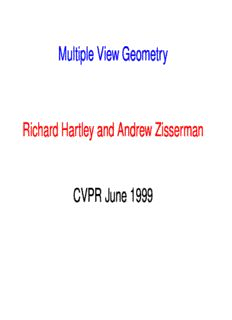
Multiple View Geometry Richard Hartley and Andrew Zisserman CVPR June 1999 PDF
Preview Multiple View Geometry Richard Hartley and Andrew Zisserman CVPR June 1999
Multiple View Geometry Richard Hartley and Andrew Zisserman CVPR June 1999 Part I: Single and Two View Geometry The main points covered in this part are: • × A perspective (central) projection camera is represented by a 3 4 matrix. • The most general perspective transformation transformation between two planes (a world plane and the image plane, or two image planes induced by a world plane) is a plane projective transformation. This can be computed from the cor- respondence of four (or more) points. • The epipolar geometry between two views is represented by the fundamental matrix. This can be computed from the correspondence of seven (or more) points. Imaging Geometry Perspective projection Y X X x X y λ y = x Y x O f Z p Z where λ = /f . Z image plane This can be written as a linear mapping between homogeneous coordinates (the equation is only up to a scale factor): X x 1 0 0 0 Y y = 0 1 0 0 Z f 0 0 1 0 1 × where a 3 4 projection matrix represents a map from 3D to 2D. Image Coordinate System Internal camera parameters y cam − k x = x x x 0 cam − k y = y y y p y 0 cam 0 x cam y where the units of k , k x y are [pixels/length]. x x 0 x α x x x x 0 1 cam cam x = y = α y y = K y y 0 cam cam f 1 1 f f where α = f k , α = f k . x x y y Camera Calibration Matrix × K is a 3 3 upper triangular matrix, called the camera calibration matrix: α x x 0 K = α y y 0 1 • There are four parameters: (i) The scaling in the image x and y directions, α and α . x y (ii) The principal point (x , y ), which is the point where the 0 0 optic axis intersects the image plane. • The aspect ratio is α /α . y x World Coordinate System External camera parameters Y cam Z X (cid:13) (cid:14) X cam O Z R t cam cam Y Y cam R, t = (cid:4) Xcam 0 1 Z Z cam O Y 1 1 X Euclidean transformation between world and camera coordinates • × R is a 3 3 rotation matrix • × t is a 3 1 translation vector Concatenating the three matrices, (cid:13) (cid:14) X x 1 0 0 0 R t Y | x = y = K 0 1 0 0 = K [R t] X (cid:4) 0 1 Z 1 0 0 1 0 1 × which defines the 3 4 projection matrix from Euclidean 3-space to an image as (cid:4) | | x = PX P = K [R t] = KR[I R t] (cid:4) − (cid:4) Note, the camera centre is at ( , , ) = R t. X Y Z × In the following it is often only the 3 4 form of P that is important, rather than its decomposition. A Projective Camera The camera model for perspective projection is a linear map between homogeneous point coordinates X x Y × y P (3 4) Z 1 1 Image Point Scene Point x = P X • The camera centre is the null-vector of P | (cid:4) e.g. if P = [I 0] then the centre is X = (0, 0, 0, 1) . • P has 11 degrees of freedom (essential parameters). • P has rank 3. What does calibration give? • K provides the transformation between an image point and a ray in Euclidean 3-space. • Once K is known the camera is termed calibrated. • A calibrated camera is a direction sensor, able to measure the direction of rays — like a 2D protractor. x α x X x 0 cam x = y = α y = Kd Y y 0 cam 1 1 Z cam Angle between rays d 1 x 1 C d .d 1 2 θ cos θ = 1 1 x 2 (d .d ) (d .d ) 2 2 1 1 2 2 d 2 (cid:4) (cid:4) −(cid:4) − 1 d d x (K K )x 1 2 1 2 cos θ = = (cid:4) (cid:4) (cid:4) −(cid:4) − (cid:4) −(cid:4) − (d d )1/2(d d )1/2 (x (K K 1)x )1/2(x (K K 1)x )1/2 1 1 2 2 1 1 2 2 (cid:4) x ωx 1 2 = (cid:4) (cid:4) (x ωx )1/2(x ωx )1/2 1 1 2 2 (cid:4) − 1 where ω = (KK ) .
Description: